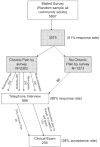The prevalence of neuropathic pain: clinical evaluation compared with screening tools in a community population
- PMID: 20849570
- PMCID: PMC2964880
- DOI: 10.1111/j.1526-4637.2009.00588.x
The prevalence of neuropathic pain: clinical evaluation compared with screening tools in a community population
Erratum in
- Pain Med. 2011 Aug;12(8):1294
Abstract
Background: Neuropathic pain is reported to be common based on studies from specialty centers and survey studies. However, few prevalence estimates have been completed in a community population using clinical evaluation.
Objective: To develop an estimate of the prevalence of neuropathic pain in community-dwelling adults.
Methods: Data from a mailed survey (N = 3,575 community respondents), telephone interview (N = 907), and a clinical examination (N = 205) were linked to estimate the population prevalence of neuropathic pain. Using the clinical examination as the "gold" standard, estimates from several screening tools were developed and adjusted to the Olmsted County, MN adult population.
Results: The estimated community prevalence of neuropathic pain from the clinical examination (gold standard) was 9.8%. Most other estimates were lower, including a 3.0% population prevalence using the Berger criteria and 8.8% using the Leeds Assessment of Neuropathic Symptoms and Signs. Only the prevalence rate based on self-report of nerve pain was higher (12.4%). Overlap among the groups each tool identified as having "neuropathic predominant pain" was only modest and the groups had significantly different rates of depressive symptoms, anxiety, limited functional ability, and use of complementary and alternative medicine.
Conclusions: The estimated rates and personal characteristics of community residents with "neuropathic pain" vary widely depending on the tools used to identify neuropathic pain. None of the screening tools compared well with clinical evaluation. The differences in the groups identified by alternative screening methods become of major importance when reporting neuropathic pain epidemiology, studying therapies for neuropathic pain, or attempting to translate neuropathic pain research into clinical practice.
Figures
References
-
- Verhaak PFM, Kerssens JJ, Dekker J, et al. Prevalence of chronic benign pain disorder among adults: a review of the literature. Pain. 1998;77:231–239. - PubMed
-
- Portenoy RK, Ugarte C, Fuller I, et al. Population-based survey of pain in the United States: differences among White, African-American and Hispanic subjects. Journal of Pain. 2004;5(6):317–328. - PubMed
-
- Watkins E, Wollan P, Melton LJ, et al. Silent Pain Sufferers. Mayo Clin Proc. 2006;81(2):167–171. - PubMed
-
- Lepine JP, Briley M. The epidemiology of pain in depression. Hum Psychopharmacol. 2004;19(Suppl 1):S3–7. - PubMed
-
- Colombo B, Annovazzi PO, Comi G. Medications for neuropathic pain: current trends. Neurol Sci. 2006;27(Suppl 2):S183–9. - PubMed
MeSH terms
Grants and funding
LinkOut - more resources
Full Text Sources
Other Literature Sources
Medical


